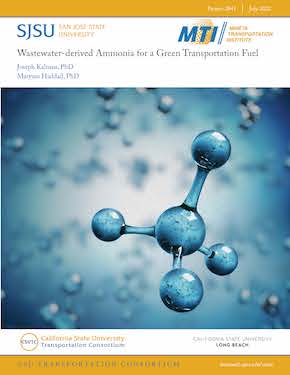- 408-924-7560
- mineta-institute@sjsu.edu
- Donate
Wastewater-derived Ammonia for a Green Transportation Fuel
The energy-water nexus (i.e., availability of potable water and clean energy) is among the most important problems currently facing society. Ammonia is a carbon-free fuel that has the potential to reduce the carbon footprint in combustion related vehicles. However, ammonia production processes typically have their own carbon footprint and do not necessarily come from sustainable sources. This research examines wastewater filtration processes to harvest ammonia for transportation processes. The research team studied mock wastewater solutions and was able to achieve ammonia concentrations above 80%(nanofiltration) and 90% (reverse osmosis). The research team also investigated the influence of transmembrane pressure and flow rates. No degradation to the membrane integrity was observed during the process. This research used constant pressure combustion simulations to calculate the ignition delay times for NH3-air flames with expected impurities from the wastewater treatment processes. The influence of impurities, such as H2O, CO, CO2, and HCl, were studied under a range of thermodynamic conditions expected in compression ignition engines. The team observed carbon monoxide and water vapor to slightly decrease (at most 5%) ignition delay time, whereas HCl, in general, increased the ignition delay. The changes to the combustion chemistry and its influence of the reaction mechanism on the results are discussed. The experimental wastewater treatment study determined that reverse osmosis produced higher purity ammonia. The findings of the combustion work suggest that ignition delays will be similar to pure ammonia if HCl is filtered from the final product.
JOSEPH KALMAN, PHD
Dr. Kalman is an Assistant Professor of Mechanical and Aerospace Engineering at California State University, Long Beach, since 2018. He received his B.S. (Rutgers University, 2008), M.E. (Rutgers University, 2010), and Ph.D. (University of Illinois at Urbana-Champaign, 2014) in Mechanical Engineering. Dr. Kalman spent four years as a researcher at the Naval Air-Warfare Center-Weapons Division, China Lake before joining CSULB in 2018. His expertise is in the areas of particle and multiphase combustion, non-intrusive diagnostics, and energetic materials. He has published 18 peer-reviewed articles and over 30 conference papers on those topics.
MARYAM HADDAD, PHD
Dr. Maryam Haddad, Assistant Professor of Chemical Engineering, has more than 10 years of experience in renewable energy, water treatment and desalination, and waste management and resource recovery. She is committed to STEM education, especially in the area of energy and environment, by directly engaging over 10 undergraduate students each year and giving practical workshops to high school students.
-
Contact Us
San José State University One Washington Square, San Jose, CA 95192 Phone: 408-924-7560 Email: mineta-institute@sjsu.edu






